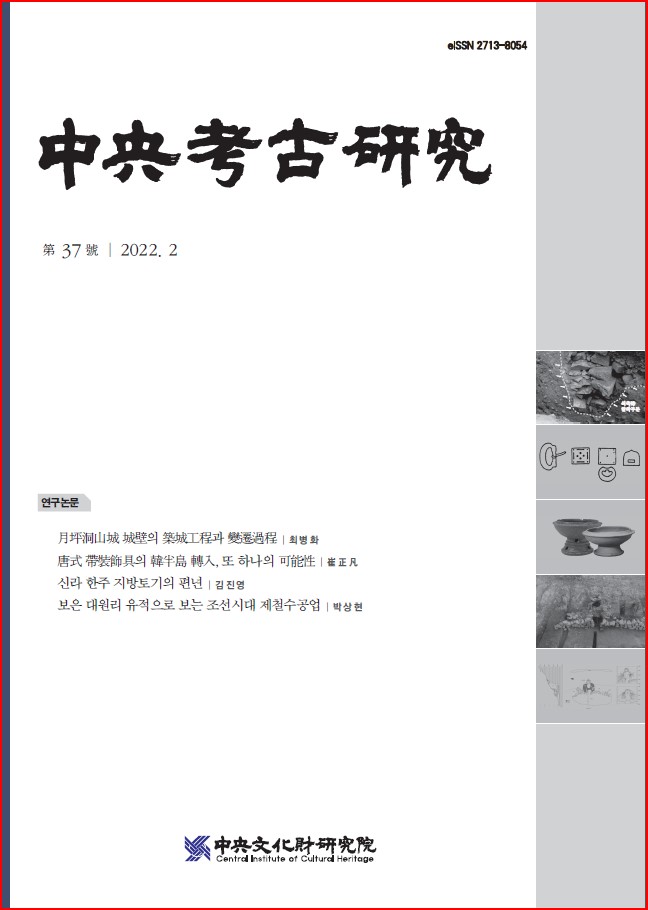
경주 탑동 목관묘 출토 청동기로 본 대외관계와 피장자의 성격
The Study on the Wooden Coffin Tombs in Tap-dong, Gyeongju and What the Finds Disclose Regarding the Characteristics of the Deceased and their Roles in Foreign Relations
경주 탑동 목관묘군은 신라의 수도인 경주 시내에서 발견된 첫 번째의 탁월한 엘리트의 무덤이다. 이곳은 신라를 건국한 박혁거세의 무덤이라고 전해지는 오릉이 위치해 있으며, 2호묘 출토의 한경은 신라가 건국되었다고 기록된 기원전 57년에 후행하는 기원전 1세기 후반 경주 시내를 지배하던 지배자의 무덤으로 보인다. 더 주목되는 것은 1호묘인데, 이 무덤은 이웃한 경주 사라리 130호묘와 거의 같은 시기의 것으로 사라리는 판상철부를 70여점 부장하여 피장자의 재력을 자랑한 반면, 탑동 1호묘에서는 판상철부를 비롯한 철기의 부장은 보잘 것 없다. 이에 비해 사라리 130호묘에서는 철복과 같은 북방계 문물도 출토되지만, 삼한경과 같은 재지계의 위신재가 주류를 이루는 반면, 탑동 1호묘에서는 중국 중원의 일광경, 호형대구를 비롯하여 북방계의 동포 등 국제적 관계를 보여주는 다양한 위신재가 출토되고 있다. 이러한 점에서 당시 경주를 중심으로 한 사로국의 지배자는 재지적인 사라리 세력과 외래 지향적인 탑동 세력 등 다양한 성격을 가진 세력의 연합체로 설명이 가능할 것이다.
The wooden coffin tombs at Tap-dong are the first tombs of outstanding elites to have ever found in downtown Gyeongju, the capital of Silla. This is also where Oreung(五陵) - the tomb of Park Hyeokgeose, who is the founding monarch of Silla - is located. The Tap-dong burial sites consist of 3 wooden coffin tombs dated in different periods, numbered 1 - 3, respectively. There are hints from the digs at the Tap-dong site that: 1. the kind of wooden coffin tomb appeared around 57 BCE, exactly at the same time when Silla started off as a small city-state by the name of Saro-guk. 2. the bronze and iron artifacts and other ornaments from this site suggest that the ruling class of Saro-guk was the association of native Jin people and displaced people whose expansionist attitudes served militarily and socio-economically as intermediators between China and northern peoples and Silla, and even further Japan. 3. all of these findings could be archaeological evidence that the earlier historical records of the origin of Silla in Samguk Sagi proves plausible. The three tombs at the Tap-dong site were built in three differentiated periods and occupied by three differentiated owners in terms of social status, but they all represented early phases of the emergence of a centralized monarchy at the heart of the capital of Silla, not in the neighboring place. The tombs were numbered 1 - 3 as they were found, and yet Tomb No. 3 is the oldest of the three, followed by Tomb No. 2. and Tomb No. 1 backwards chronologically. Tomb No. 3 produced no distinguished prestige goods of bronze except some earthenware, by the chronological dating of which this tomb is presumed to have been built around 57 BCE. It marks the beginning of the construction of wooden coffin tombs in this area. Tomb No. 2 can be thought of a prelude to a new political entity of Gyeongju beginning its journey to the Unified Kingdom. It is the first of a series of tombs where the Chinese bronze mirrors were deposited by those who ruled downtown Gyeongju in the late 1st century AD, about the same time as Tomb No. 38 at Joyang-dong, Gyeongju. Tomb No. 38 at Joyang-dong, however, produced 4 Chinese bronze mirrors and a fragment of a reprocessed Chinese bronze mirror, which means that the deceased as a stronger manager who boasted his financial power capable of possessing valued items, such as Chinese bronze mirrors, was competing against the Tap-dong tomb owner nearby, about 8 km or only a 2-hour walk apart in Gyeongju at the time. The finds from Tomb No. 1 at Tap-dong can be interpreted that at least two groups of separate interests had a rational division of function along the supply chain of iron artifacts in present-day Gyeongju around the mid 1st century AD: One was in charge of producing ironwork and the other was responsible for trading them, organizing guild-like professional associations; The first group consisted of people who were able to bury their leader with a good number of highly valued iron artworks in his grave. On the other hand, the second group consisted of people who boasted their prestige and authority by placing multiple decorative bronze items, such as swords, buckles, buttons, and bracelets, in their leader’s burial. Sarari people as locals would have settled down here in Gyeongju from the beginning of the Bronze age and been familiar with dealing with iron. Alternately, Tap-dong people could be the displaced refugees who had fled from the Northern part of Korea after the fall of Wiman Joseon. That’s why they could have been flashily dressed like one of them and engaged in foreign trade with Northern nomadic people.
Ⅰ. 머리말
Ⅱ. 탑동 목관묘 출토 청동기의 특징
Ⅲ. 탑동 목관묘 단계의 대외관계
Ⅳ. 탑동 목관묘의 피장자의 성격과 진한의 지배자
Ⅴ. 맺음말